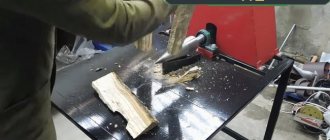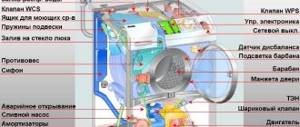Homemade cars
Buggy “Barracuda” made by hand, Nikolai Zubik from Melitopol: detailed photo report on the assembly of the buggy.
An interesting project of a Barracuda buggy with an engine from a Yamaha R1 motorcycle. Below is a photo and description of the design.
The frame was made from pipes 3 mm thick, internal diameter 20 and 25 mm. Levers are made from the same metal as the frame. In total there were about 100 meters of pipes.
Making a frame for a buggy.
The suspension arms are also homemade.
I thought for a long time about which coin to take as a donor. I wanted a liter engine, after talking with motorcyclists I realized that the most problem-free engines are Honda and Yamaha. I started calling around looking for one.
A motor with an outboard, there were options for 2000 euros, as it was a bit expensive for the engine, I began to look for a motor without documents. About a month later I found a 2003 Yamaha R1 in Zaporozhye. A couple of days later I went and looked, the bike was in excellent condition, and it was picked up the same day.
To make a rear gearbox, the money is almost the same as half a buggy, a lot of turning work, you can see everything in the photo, I did everything from iron. Drive shafts were taken from BMW 34 and lengthened by 10 cm.
The radiator was installed by a VAZ from a classic, the pipes are also from a VAZ, the thermostat is from a Yamaha, everything else is also from a Yamaha, the only pipes are temporary, after painting I will make them from a metal pipe.
I installed the front calipers from Oka.
All tests have been passed, weaknesses have been identified. The shock absorbers turned out to be weak (it was foolish to hope that homemade shock absorbers would turn out great the first time). Rear sprocket 43 teeth is not enough (you need 65 to know about this). The brakes, the front disc is hitting, we need to figure it out. Gearbox, you need to start the gearbox cable differently. Now about the pros. It steers like it's on rails, and at any speed. It accelerates like a shot from a cannon, after 7000 rpm. presses into the seat and holds up to 12,000 rpm. The suspension works perfectly, in principle everything is ok, there are no more questions, now the final assembly will begin.
The first time I rode on a 43 tooth sprocket removed from a motorcycle, in fact I installed sprockets from a motorcycle and the gear ratio was the same as on a motorcycle, that is, theoretically the maximum speed is 300 km, but the weight of the buggy is twice as much as a moto, but even on this sprocket it rode very brightly. Now there is a 65 teeth star, the buggy starts off without gas at all (no different from a passenger car) and let me tell you, it crashes hard.
Video of rides on a homemade buggy:
Author of the project: Nikolay Zubik. Melitopol.
Share on social media networks
Interesting homemade products on our website
- Homemade mini-buggy: photo and description of the design
- DIY buggy: photo and description
- DIY buggy: photo, video and description
- Buggy from Oka: drawings, photos
- Homemade buggy from Tavria
- Homemade buggy
- Homemade buggy with your own hands
- Homemade buggy from SMZ motorized carriage
Let's start building buggies
The article is structured in the form of a dialogue and answers many questions from beginning DIYers.
N. _ This will be our Newbie. Young, hot, and a little clueless, but full of strength and energy. M. _ We will have a Master, experienced, who has already experienced disappointment after failures, but who remains faithful to the cause of self-stick construction. Let's just say, a more down-to-earth substance, but also a creative nature.
M. _ So you decided to build a buggy? N. Where to start? M. I think it all starts with a dream. So let's dream. N. I want to build a car that is beautiful, powerful, all-accessible, so that it can tear everyone apart, well, in general, so that girls piss with boiling water. I am a hero, I am the best... M. Stop, stop, stop. I'm daydreaming! Yes, you are the best, but do you have money? N. Yes, how much money is needed, the donor is 200 bucks, the pipes are 50 bucks here and there, another 100, and the device is ready. M. That’s the first mistake. Let's start with iron. I can deceive you, you can deceive me, IT IS IMPOSSIBLE TO DECEIVE IRON, IT DOES NOT HAPPEN. Donor, showdowns, landfills, it's all good. But in the car there are disposable parts - oil seals, piston rings, liners, balls, brake hoses, etc. And finally, oil and brake fluid. N. Yes, these are all little things! M. Separately, yes, but in a heap a fairly decent amount accumulates. Add to this the payment to people. N. I will do everything myself! M. Don’t interrupt your elders, it’s a bad habit! Do you turn the part yourself on a lathe? Or will you capitalize on a motor that you only saw in the picture? No, you have to pay for it, maybe a bottle for someone, a clearing for someone, but it’s still an expense. So don’t give yourself any illusions, the amount will be somewhat larger than you think. N. Oh well, I’ll get out, the old people will help, I’ll work somewhere…. M. Okay, accepted. Question two, where will you build? N. Well, somewhere... M. No, that won’t do. To build a machine, you need a room where you can store spare parts, tools, and where you can work normally without disturbing others. N. I’ll rent a garage. M. Well, there are expenses again! Nevermind. Next question. What are you going to build with? N. And I have pliers, a screwdriver, keys, and something else. M. Yeah, what the hell are you going to build with such a tool. Just think, even to tear apart a rusty donor, you will need sockets, spanners, and an angle grinder. Otherwise you'll just beat your hands. I know you young, one by one, two by the balls. By the way, don’t forget about the first aid kit, it will come in handy. And when you start building, you will need a workbench, a vice, a drill, welding, I’m not talking about such perversions as a pipe bender, sandblasting, and a welding table. You can do without this for the first time. Although I recommend that you do not skimp on tools. You see the expenses again. N. Well, if I listen to you, there’s no need to build anything at all. M. Damn, I'm sick of it! Leave this youthful maximalism, it’s all or nothing. If you want to build, build. If a person does not do what he wants, his character deteriorates. And I’m not interested in communicating with hysterics. If you decide, then set yourself a real task. Don't try to fuck the queen, because you're not a king yourself. Little time has passed. N. The master has money, rented a garage, prepared the tools. Let's build!!! M. Damn, I have a fever again. What to build? N. Like what, buggy! M. Which buggy? N. Well, so that she... Well, so that I... Well, in general, with a chick! M. Yes, a comprehensive description of the vehicle. To begin with, why a double, start with a single. N. Motivate. M. Firstly, the machine is more compact, lighter, the motor can be installed not very cool, for example from Oka. Secondly, you have little experience, well, to be honest, none at all. In an extreme situation, you will kill a passenger. But for some reason I don’t want you to go to jail. Ahead of time. And thirdly, you have the first car, and with a single-seater there is less hassle. N. No, I want a double one. M. Well, okay, with a chick, so with a chick. Then let's do the math first. N. What are you talking about, I have 9 years of education, what are the calculations? M. Calm down, dunce. Basically everything, smart people figured it out before you. Well, I hope you can multiply two by two. Let's start with the weight of the machine. N. Why do I need it? I’ll build it and weigh it. M. You interrupt again. We need the weight of all components and engine power in order to estimate, at least approximately, the cross-section of the frame pipes, and in general, to know what to expect from the car. N. How to calculate the weight. M. A lot of the units are in the donor’s repair manual, you must have it. To weigh small things, buy hand scales. The weight of the pipes is easy to calculate from the price list from the metal warehouse, it has two columns, Price per meter and price per ton, so use the money to calculate how much a meter weighs. Just don't take wholesale prices. N. I counted. M. Yeah, it’s a little hard. The motor is rather weak. N. I've had enough. M. You're being stupid again. This will be enough for you at first, until you know how to drive even well. And when you learn, there is no limit to perfection. N. Then I’ll speed up the engine. M. Also a motor mechanic for me, a booster. If we force it, it will be something worthwhile and not this dead meat. Remember this procedure, even if everything works out for you, it will add 20 - 30 percent. And this will not save you in any way. N. But what should we do? M. Let’s include in the project, for the future, the possibility of installing a more powerful motor. For example, VAZ-2108, they are similar in layout, you just need to leave some space. N. Okay, the project is ready, let's cook the frame. M. What project? These are only sketches with dimensions, and they are quite approximate. N. How boring you are, you won’t please. M. Since it is not possible to make drawings, we will do it according to our minds, that is, according to the place. Make a model of the car from donor components and parts, lay out everything: motor, levers, wheels, seats, battery, rack. Everything, including the ignition coil. Place beer crates, you have a lot of them, boxes, boards, tie up wires. You should end up with a fully assembled, life-size car, just without the frame. If some component or part is missing, it is better to buy it immediately, or, as a last resort, make a life-size model. Now walk around this heap of iron, think, rearrange the parts, try to sit behind the wheel and see if it’s comfortable for you. Lay out the parts compactly; the dimensions of the machine depend on this. Try to place heavy things as low as possible; we don’t need a high center of gravity. Watch the weight distribution both along the axles and on the sides. Don't forget about the availability of units for repair. Take advice from smart people (I don't mean myself). The main thing is not to rush, every fruit must ripen. And when you have green little devils running before your eyes, and you come to the conclusion that things cannot be better, we will start drawing the frame. The method is not entirely scientific, but it is simple and reliable. And so, gentlemen, the first part of the work is finished. I would like to hear your opinion, both beginners and luminaries. If you are interested, Novichok and I will continue building turnkey buggies. We will try to cover all the issues related to the PRACTICAL construction of the machine. Well, if not, then we’ll leave it at that. Sincerely, Mechanic and Newbie
Main components and mechanisms of the Oka buggy
When creating a sports car, special attention should be paid to the driver's seat. If the car is a two-seater, then you need to decide how the driver’s seat will be positioned and how it is more comfortable to sit down. It is necessary to calculate the installation of instrument panels, the location of the gearbox, levers and many other components. After this, you can start building a frame for the Oka buggy. The next important step is to install the engine. The most common option is to mount it in the rear, followed by a rear-wheel drive design. In this case, there is no need to connect the rear and front axles, and the steering mechanism will not be located together with the vehicle's traction unit. Rear-wheel drive will provide more maneuverability and comfort during extreme driving.
What types of shock absorbers are there?
Every car, motorcycle, and many bicycles have shock absorbers. This article describes the main types of modern shock absorbers, what they are needed for, what types they are, and which designs are more effective. The main types of shock absorber mounts are also discussed.
At first glance, the job of a shock absorber is to dampen vertical vibrations of the car. However, we must not forget about the influence of shock absorbers on acceleration and braking dynamics. So, when accelerating, the car “squats” backward, loading the rear wheels and unloading the front wheels, thereby reducing their grip on the road. When braking, the opposite picture is observed. The main load falls on the front wheels, so on front-wheel drive cars the front brakes take on about 80% of the work.
The picture is approximately the same when maneuvering, but here the load shifts not along the axes, but along the sides of the car. In general, we can say that the main task of shock absorbers is to keep the wheel in constant contact with the road, which is especially important for a buggy, because high-speed movement on bad roads requires precise control of the vehicle.
Let's start with the most common types of shock absorbers and gradually move towards improving performance characteristics, and, of course, prices :).
Hydraulics…
Hydraulic twin-tube shock absorbers are the most common and cheapest type of shock absorbers. They are quite simple in design and not so demanding in terms of workmanship. Such a shock absorber consists of two tubes: a working flask, where the piston is located, and an outer casing designed to store excess oil. The piston moves in the inner flask, passing oil through its own channels and squeezing some of the oil through the valve located at the bottom of the flask. This valve is called the compression valve, since it is often responsible for the flow of oil in a given stroke. This portion of the fluid seeps into the cavity between the bulb and the outer housing, where it compresses the air at atmospheric pressure at the top of the shock absorber. When moving backwards, the valves of the piston itself are activated, adjusting the rebound force. For a long time, this design prevailed on the shock absorber market. But years of operation have revealed a number of its shortcomings. The main disadvantage is aeration. Especially with intensive work of such a shock absorber. In addition, such shock absorbers, having actually a double body, are cooled worse, which also negatively affects their performance.
…plus gas
Such hydropneumatic shock absorbers have a similar design and operating principle to conventional hydraulic double-pipe struts. The main difference is that instead of air under atmospheric pressure, there is an inert gas (usually nitrogen) under some pressure (from 4 to 20 atm or more, depending on the purpose). This is the so-called gas boost. The gas pressure value may be different for different vehicle operating conditions. How does gas boost help? First of all, the notorious aeration. Being under pressure, the gas does not mix with oil as much as in the previous case, improving the performance of the shock absorber. But this problem has not been completely solved here either. In addition to reducing oil aeration, the gas boost helps support the vehicle by acting as an additional damper. That is, even if the springs would have already compressed, the gas charge in the shock absorber maintains the correct position of the car, which has a positive effect on its handling. This design approach allows engineers more flexibility in how the shock absorber operates, making it more versatile than conventional hydraulic shock absorbers. A common problem with all twin-tube shock absorbers is the inability to install upside down. This is prevented by the gas filling them.
One pipe
Such shock absorbers, as the name suggests, have only one bulb, which is both a working cylinder and a housing at the same time. They work in the same way as two-pipe ones, but in this design the gas is in the same cylinder and is separated from the oil by a special floating piston (the so-called De Carbon scheme). The gas (usually nitrogen) is in its chamber, separated from the oil, under high pressure (20–30 atm). Monotube shock absorbers do not have a lower compression valve like twin-tube shock absorbers. This means that all the work of controlling resistance during both compression and rebound is taken over by the piston. In this regard, despite the apparent simplicity of this unit, selecting its design, size, shape and number of holes is a very difficult task. In general, such shock absorbers have high performance characteristics. They hold the car even more precisely, contributing to better handling. In addition, they are cooled more efficiently, since air is blown directly onto the working cylinder. Plus, in the same dimensions as twin-pipe shock absorbers, the internal diameter of the working flask will be larger, as well as the diameter of the piston. This means more oil capacity, more consistent performance and, again, better heat dissipation. But there are also disadvantages.
Unlike their two-pipe “colleagues”, single-pipe ones are more vulnerable to external damage. A jammed bulb definitely leads to replacing the shock absorber, while two-pipe ones are much less vulnerable, they have a shield in the form of an external cylinder. The disadvantages also include the high sensitivity of monotube shock absorbers to temperature. The higher it is, the higher the gas pressure and the harder the shock absorber works. On the other hand, mono-tube struts can be installed in any way as the gas is tightly separated from the oil by a floating piston. By the way, it is precisely this circumstance that allows automakers, by installing such a shock absorber with the rod down, to reduce unsprung masses.
It should also be said here that you can often find shock absorbers with a spring attached to them. This design option does not apply exclusively to single-pipe racks. This is simply how the compactness of the unit is achieved and the spring and shock absorber are combined in “one bottle”. Such designs often have the ability to adjust the vehicle's ground clearance. By tightening a special screw nut on the shock absorber body that supports the spring from below, you can raise or lower the car, respectively, tightening or releasing the spring.
A kind of evolution of monotube shock absorbers are “monotube” shock absorbers with a remote compensation chamber. In them, the chamber with gas pressure is placed outside the shock absorber itself in a separate tank. This design allows, without increasing the size of the shock absorber itself, to increase the volume of both gas and oil, which seriously affects the temperature balance (they are cooled more efficiently) and stability of characteristics. Plus, they have a larger stroke. But an even greater effect from the remote chamber is that on the path of the oil flowing from the main working cylinder to the additional chamber, you can install a system of valves that will play the role of a compression valve, as in a two-pipe design. By separating the compression and rebound valves from each other, many adjustment ranges can be created. You can change the stiffness of the shock absorber for different piston speeds, for example, low, medium and high. And there can be 10 or more positions of such adjustments.
Shock absorber mountings
Everything is simple here, one picture and everything is clear. As a rule, shock absorbers with two eyes are installed on buggies since the suspension travel is large and the angles of operation of the shock absorbers vary greatly. However, there are solutions when a threaded bushing with a welded eye is screwed onto a shock absorber that has a thread on the rod.
The article uses materials from the sites https://vaz.ee and https://plaza.spb.ru
What to choose
Basically, the Oka buggy drives on difficult dirt tracks with jumps and hills. To assemble your own sports car, you need to decide on the basis of which car the design will be carried out. For an inexpensive car, the Zaporozhets models are well suited, but the Oka has proven itself best. Of course, you can build a buggy from scratch. But, in addition to the fact that the frame is assembled from iron pipes, it is necessary to purchase an engine and many mechanical components. And this is a large financial and time investment and a lot of physical labor. Initially, these cars were designed for driving through deserts and beaches. They are descendants of the Desert Raider vehicles of World War II. Modern buggies are sports SUVs that will bring a lot of fun and extreme sports. Despite aggressive off-road driving, the buggy is safe and comfortable. The driver is firmly tied to the seat with a special sports seat belt, which will not allow him to fly out of the cabin. And the strong structure does not deform even in the event of serious accidents. Buggies often take part in desert races.
How to make a buggy out of Oka
The most common option for building a sports car is based on the Oka car. It was produced from 1988 to 2009. During this time, car dealerships managed to sell a large number of cars. "Oka" is still considered the cheapest car in the world. If there is already a donor in the form of “Oka” for the future buggy, then you can start designing and building. Engine with a volume of 750 cc. cm and a power of 33 horsepower is easily suitable for extreme driving. You should pay close attention to the wheel joints: the torque depends on this. The main responsible part when building a buggy with your own hands from Oka lies on the suspension. It is worth taking this issue seriously, because traffic safety depends on it.
A real mini-buggy with your own hands
Every child dreams of riding a go-kart, scooter, moped, or motorcycle, but when it comes to a real buggy, there is practically no limit to his delight.
Making this type of transport is not difficult, you only need a little desire. You just need to successfully purchase a 125 cm3 scooter engine. [media=
https://youtu.be/B4SN9kWU54s
]
[media=
https://youtu.be/wTzt_8OLvQU
]
Materials and tools for homemade work • 125 cm3 engine; • old metal water pipes; • electric welding; • wheels 10 inches; • steering rods from VAZ 2101; • scooter shock absorbers; • brake pads.
Buggy manufacturing process
Step 1. Making the frame and steering
Using ordinary water pipes of different sections and profiles, a frame is made for the future buggy. Metal parts must be connected using conventional electric welding.
It is optimal to take regular 10-inch wheels from a scooter. The suspension is independent pendulum, with shock absorbers in both directions. In a regular go-kart, control is done through the steering rack; in a homemade buggy there will be no steering rack. You just need to find steering rods from the Zhiguli “Kopeyka”. Driving a buggy will be more difficult than a regular go-kart.
Step 2. Differential
To have reverse gear and differential in the buggy, you need to use a gear axle from the Ant scooter; it has everything we need. To reduce engine vibration, it must be firmly bolted to the frame. The drive should be located in accordance with the center of the pendulum mounting, thus making it possible to adjust the chain tension.
Brakes are installed only on the rear wheels. There are brake drums on each axle shaft and they stop the buggy very well. It is necessary to get the cables from the Zhiguli hand brakes. When you press the pedal, they activate the brake pads on each drum.
Step 4. Final stages of assembly
The fuel tank is also taken from any scooter. The seat from Zaporozhets is ideal for a mini-buggy; it can easily be adjusted to suit any height. We put everything in its place and enjoy using this homemade product.
Conclusion
Buggy at home is difficult to do, but it is possible. You need to walk around the market and find the parts you need. With a 125 cc engine, the maximum speed of the buggy will exceed 50 km/h. Source
Become the author of the site, publish your own articles, descriptions of homemade products and pay for the text. Read more here.




